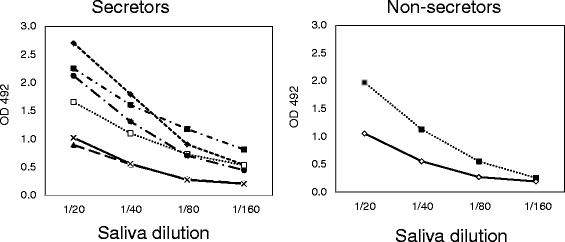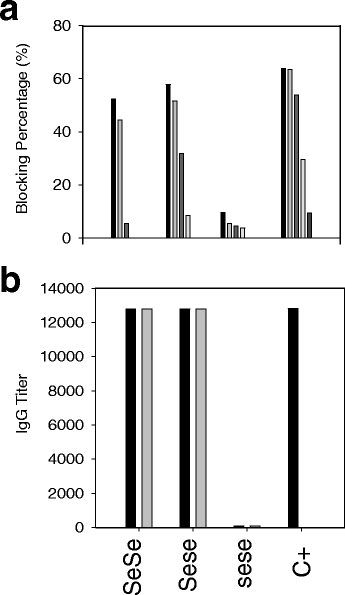Characterisation of a household norovirus outbreak occurred in Valencia (Spain)
- PMID: 26968797
- PMCID: PMC4788899
- DOI: 10.1186/s12879-016-1455-9
Characterisation of a household norovirus outbreak occurred in Valencia (Spain)
Abstract
Background: Human noroviruses (NoVs) are the main cause of non-bacterial gastroenteritis worldwide. Several studies have linked human susceptibility to NoVs with the expression of histo-blood group antigens (HBGAs). In January 2012, a NoV gastroenteritis outbreak affected a household in Valencia, Spain, and the personal susceptibility to NoV was investigated.
Methods: To reach this aim 8 members of the affected household were recruited for this study and their secretor status, ABO and Lewis antigens were determined. NoV-specific saliva IgA and serum IgG antibody titers were analyzed. Their capacity to block viral binding to saliva receptors was analyzed, using virus-like particles (VLPs) of the NoV GII.4 genotype, 2006b variant, and saliva from a secretor O blood type donor.
Results: The most relevant finding was that an asymptomatic non-secretor individual shed NoVs in his stools. Interestingly, anti-NoV IgA antibody titers in saliva from secretor and non-secretor individuals showed no differences. On the contrary, high titers of NoV-specific IgG antibody were found in both convalescent sera and in sera collected 1 year post-infection, but only from secretor individuals. NoV GII.4-2006b VLP binding to receptors present in the saliva was efficiently blocked only by sera from secretor positive individuals.
Conclusions: Despite the small number of individuals involved in this outbreak, this study reinforces the idea that susceptibility to human NoV is both dependent on the HBGA profile of the individuals as well as on the viral genotype and variant. We also show that the immunity to NoV lasts for at least 1 year after infection, demonstrating that symptomatic infections strongly stimulate immune responses.
Keywords: Binding assay; FUT2; Histo-blood group antigens; IgA; IgG; Norovirus; Secretor; Susceptibility; Virus-like particles.
Figures


Similar articles
-
Relationship between GII.3 norovirus infections and blood group antigens in young children in Tunisia.Clin Microbiol Infect. 2015 Sep;21(9):874.e1-8. doi: 10.1016/j.cmi.2015.05.015. Epub 2015 May 21. Clin Microbiol Infect. 2015. PMID: 26003283
-
Human Sera Collected between 1979 and 2010 Possess Blocking-Antibody Titers to Pandemic GII.4 Noroviruses Isolated over Three Decades.J Virol. 2017 Jun 26;91(14):e00567-17. doi: 10.1128/JVI.00567-17. Print 2017 Jul 15. J Virol. 2017. PMID: 28468886 Free PMC article.
-
Characterization of emerging GII.g/GII.12 noroviruses from a gastroenteritis outbreak in the United States in 2010.J Clin Microbiol. 2011 Sep;49(9):3234-44. doi: 10.1128/JCM.00305-11. Epub 2011 Jul 13. J Clin Microbiol. 2011. PMID: 21752978 Free PMC article.
-
Norovirus and histo-blood group antigens.Jpn J Infect Dis. 2011;64(2):95-103. Jpn J Infect Dis. 2011. PMID: 21519121 Review.
-
[Interaction between noroviruses and human histo-blood group antigens].Uirusu. 2007 Dec;57(2):181-9. doi: 10.2222/jsv.57.181. Uirusu. 2007. PMID: 18357756 Review. Japanese.
Cited by
-
Norovirus-Associated Gastroenteritis Vesikari Score and Pre-Existing Salivary IgA in Young Children from Rural South Africa.Viruses. 2023 Oct 30;15(11):2185. doi: 10.3390/v15112185. Viruses. 2023. PMID: 38005863 Free PMC article.
-
Norovirus transmission mediated by asymptomatic family members in households.PLoS One. 2020 Jul 23;15(7):e0236502. doi: 10.1371/journal.pone.0236502. eCollection 2020. PLoS One. 2020. PMID: 32702014 Free PMC article.
-
Impact of Pre-exposure History and Host Genetics on Antibody Avidity Following Norovirus Vaccination.J Infect Dis. 2017 Mar 15;215(6):984-991. doi: 10.1093/infdis/jix045. J Infect Dis. 2017. PMID: 28453838 Free PMC article. Clinical Trial.
-
The Interactions between Host Glycobiology, Bacterial Microbiota, and Viruses in the Gut.Viruses. 2018 Feb 24;10(2):96. doi: 10.3390/v10020096. Viruses. 2018. PMID: 29495275 Free PMC article. Review.
-
Linear epitopes on the capsid protein of norovirus commonly elicit high antibody response among past-infected individuals.Virol J. 2023 Jun 6;20(1):115. doi: 10.1186/s12985-023-02087-y. Virol J. 2023. PMID: 37280660 Free PMC article.
References
-
- Lindesmith L, Moe C, Marionneau S, Ruvoen N, Jiang X, Lindblad L, Stewart P, LePendu J, Baric R. Human susceptibility and resistance to Norwalk virus infection. Nat Med. 2003;9(5):548–53. - PubMed
Publication types
MeSH terms
LinkOut - more resources
Full Text Sources
Other Literature Sources
Medical
Miscellaneous

